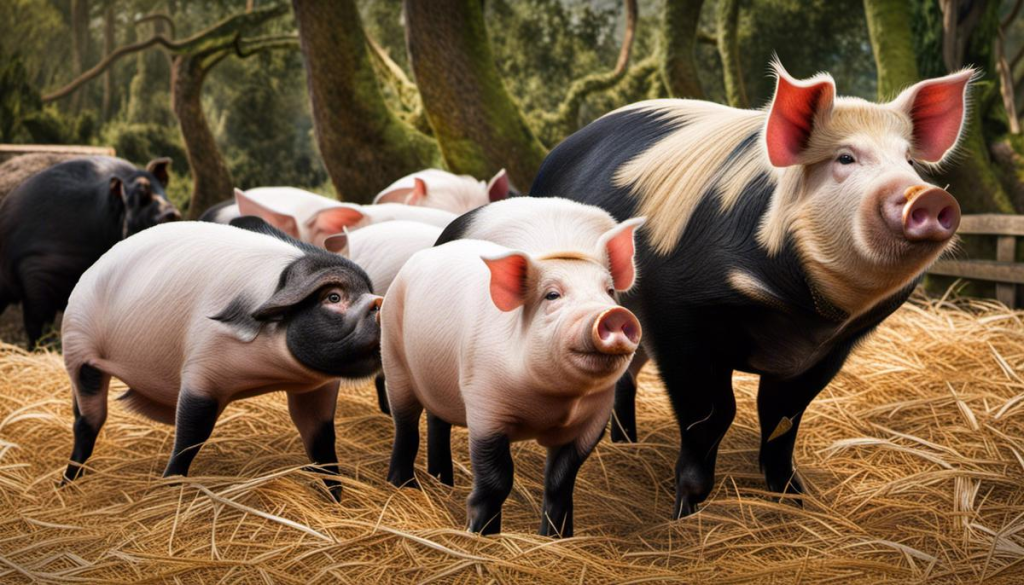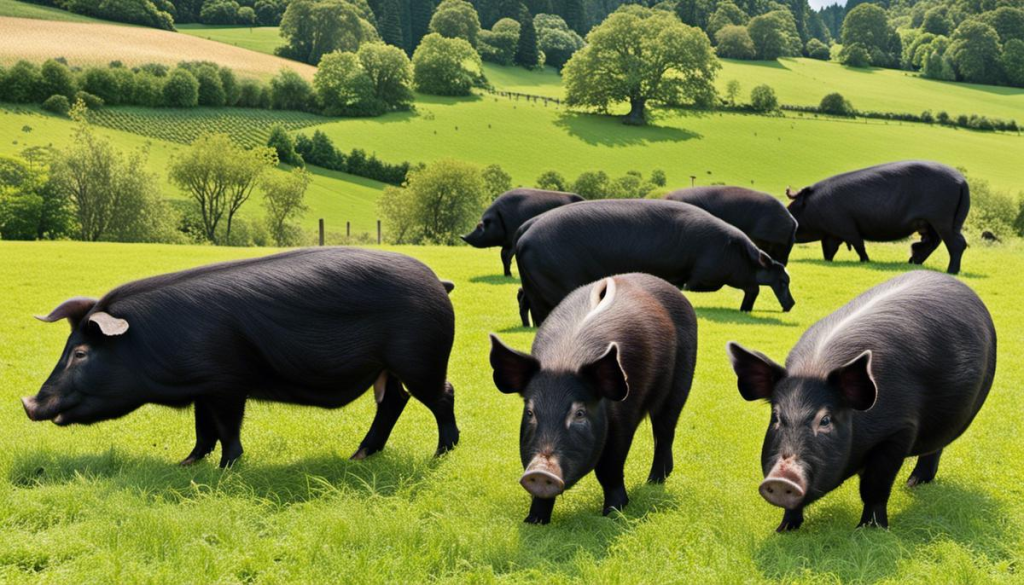In the diverse world of pig breeds, the British Saddleback pigs stand out for their unique physical features and economic values. With their distinct color and shape, combined with their robustness and productive reproduction, these pigs play a vital role in the landscape of pig farming. This exploration deep-dives into understanding their distinct physical attributes and behaviors, strategies for their effective care and breeding, and the significant roles they play in traditional farming and conservation efforts. Their hardiness, combined with an ability to produce high-quality meat, also underscores their importance in economic models.

Physical Characteristics and Behavior
Physical Characteristics of British Saddleback Pigs
The British Saddleback pig is a distinctive breed known for its robust and hardy nature. This breed typically grows to a size of about 600-750 pounds for males and 500-600 pounds for females. Its body is a medium length, with a straight back leading to a slightly lopsided rump. The pigs have lopped ears that hang down either side of their face, obscuring much of their eyes.
One of its key special physical attributes is its color pattern. The British Saddleback displays a characteristic black and white color, with a white band, also called the saddle, covering the front legs around the shoulders. The rest of the pig, aside from the saddle, possesses a glossy black color.
One additional notable physical feature of this breed is their hardiness. The skin of the British Saddleback pig is thick, enabling it to withstand various weather conditions. They are also known for their excellent foraging capabilities due to their long snouts.
Behavior and Temperament of British Saddleback Pigs
British Saddleback pigs are known for their calm and good-natured behavior. They are one of the more docile breeds, making them popular among farmers and smallholders. Their tranquil demeanor also contributes to their ability to nurture and care effectively for their litters without displaying aggressive behavior.
In terms of interaction with the environment, the British Saddleback is a hearty breed. Its propensity for outdoor living and excellent foraging skills make it well-suited for free-range and organic farming systems. Given their strength and stamina, these pigs are often put to use as grazers in orchards and woodlands.
British Saddleback pigs are sociable animals. They can often be seen comfortably snuffling and rooting alongside their fellow herd members. Being adaptable and hardy, they show a reasonable tolerance to various climate conditions and are capable of thriving productively in different environments. Their placid nature combined with their resilience and adaptability make them a preferred breed for self-sustainable farming practices.
The pigs also display strong maternal instincts. Females, or sows, are renowned for being excellent mothers. The British Saddleback is known for its high fertility rates and successful rearing of large litters. It’s not uncommon for a sow to have litters of up to 10 piglets.
Understanding British Saddleback Pigs and Their Environment
The very essence of the British Saddleback pig lies in its identity and interaction with its environment. These pigs are superior foragers, feeding on a surplus of plant species and even small animals when required. Their effective grazing abilities make them essential in land management by helping control weed and unnecessary plant growth.
Not only do these pigs interact with their environment, but they also significantly influence it via their foraging behaviors. Their habit of naturally aerating the soil whilst foraging enhances its quality and nutrient density, making it substantially more fertile and promoting better plant growth.
In a nutshell, British Saddleback pigs are resilient and friendly, adored by farmers and breeders alike for their adaptability and agreeable disposition. From their distinctive physical characteristics to their environmental behavior, the British Saddleback breed is indeed a precious contribution to agriculture.

Caring for British Saddleback Pigs
Nutritional Needs of British Saddleback Pigs
As omnivorous, British Saddleback pigs consume a diverse diet. Their primary food source is commercial pig feed, which they supplement with green veggies, fruits, and occasional grain servings. Pig feed comes in two forms: starter feed for piglets and grower/finisher feed for grown pigs. It’s crucial to guarantee the pig feed is devoid of ruminant materials, feeding such is against U.S. law. Additionally, a consistent supply of fresh and clean water is necessary for pigs.
Space Needs
Saddlebacks are a hardy breed and can be reared outside all year round, although a shelter to protect from harsh weather is important. Sufficient space is vital for their overall well-being. For outdoor rearing, a minimum of 50 square feet per pig is recommended. If housed indoors, space requirements increase with the pig’s weight: 3 square feet for a piglet, up to at least 24 square feet for a mature pig.
Health Considerations
Similar to all pig breeds, British Saddleback pigs are susceptible to several health issues. Regular health checks are essential to detect issues early on and start treatment before it worsens. Common health issues include parasites, skin conditions, respiratory diseases, foot and leg issues, and reproductive disorders. Regular vaccination and deworming should be part of the care regime.
Dental care is another significant area to monitor. Abrasions and infections can frequently occur due to the pig’s natural tendency to root and dig. Regular dental checks and treatments, if necessary, can help keep these issues at bay.
Environment Management
Proper environmental management is integral to the health and happiness of British Saddleback pigs. This includes ensuring clean and dry living conditions, plenty of access to fresh air and sunshine, providing enrichment activities to prevent boredom and destructive behavior, and keeping the pigs away from draughts or direct intense heat.
Prevention of Pests and Diseases
The implementation of effective prevention strategies for pests and diseases is crucial for the wellness of British Saddleback pigs. Implementing regular health evaluations, maintaining excellent hygiene standards, adhering to vaccination schedules and enforcing quarantine rules for both new and ill pigs can significantly boost their health. Pests like rats and birds can quickly spread diseases among these pigs, hence the necessity of pest management measures. Always remember to get professional advice from a vet on the care and maintenance of the British Saddlebacks.

Breeding and Productivity
The Breeding Protocol for British Saddleback Pigs
The breeding of British Saddleback pigs is a meticulous process designed to preserve their superior attributes. This breed is renowned for its adaptability, hardiness and resistance, characteristics that favor them in different climates and environments. The distinct black and white coloring that presents white ‘saddle’ spanning across the shoulders and front legs is unique to the Saddleback. It’s therefore essential that the breeding process maintains these signature traits.
Reproductive Habits and Litter Size
On average, the gestation period for British Saddleback pigs is approximately 114 days, or three months, three weeks, and three days, a common gestation period among pig breeds. Sows characteristically produce two litters per year. The quantity of piglets, or litter size, is largely dependent on the sow’s condition and health, though genetic factors play a significant role too. The British Saddleback’s average litter size ranges between 8 to 10 piglets.
Productivity of British Saddleback Pigs
British Saddleback pigs are recognized for their prime productivity. They are particularly appreciated for their pork production, rendering large volumes of succulent meat with a generous layer of back fat which is advantageous for bacon and sausage production.
This breed is praised for the superior quality of its meat which is flavorsome and has a unique texture, attributed to the slow growth rate and outdoor rearing of the pigs. While this might mean a higher cost and longer time for raising them, the end result of the higher-quality pork is often viewed as worth the investment.
Additionally, this breed’s ability to thrive on pasture and their strong rooting tendencies make them valuable for soil aeration and turning over uncultivated land. Resilient and adaptable, the British Saddleback can be raised in diverse environmental conditions, further increasing their productivity potential.
Other uses of British Saddleback Pigs
British Saddleback pigs serve more than just gastronomic purposes. These large animals are beneficial for managing vegetation and controlling pests due to their natural foraging instincts and will readily consume insects, grubs, and small reptiles as part of their diet. Some farmers make use of Saddleback pigs in woodland management, where they help to clear underbrush and promote the growth of native plants. As such, they’re often seen as a valuable addition to sustainable farming systems. Their affable nature also makes them a popular choice for educational farm visits and petting zoos.
A Comprehensive Overview
British Saddleback pigs offer a unique combination of efficiency in breeding, high-quality meat production, significant environmental benefits, and versatility in their uses. These factors come together to make these pigs a valuable resource in both commercial and small-scale agriculture.

Economic and Conservation Importance
The Economic Significance of British Saddleback Pigs
British Saddleback pigs play a fundamental role in British agriculture, stemming from their capacity for producing high-quality meat. They possess a robust adaptability to both indoor and outdoor farming, making them a favorite choice among pig farmers. Regardless of the weather or geographical variations, these pigs demonstrate great hardiness, thriving in a range of climates and environments.
From a meat production perspective, British Saddlebacks are renowned for their delightful pork and bacon. Their meat is distinctive in both flavor and texture, largely attributable to their unique genetics in combination with a natural, free-range lifestyle. In addition to great taste, the pork from these pigs offers a balanced ratio of lean meat to fat, making it perfect for gourmet consumers who value quality.
A significant economic benefit of the British Saddleback breed is their impressive breeding capability. Sows are able to produce large litters, usually giving birth to an average of 10 to 12 piglets. They possess strong maternal instincts, contributing to higher piglet survival rates. Their robust health and minimal need for veterinary care further reduce expenditure on health services, adding to their economic value.
British Saddlebacks and Conservation Efforts
The unique genetic traits of British Saddleback pigs have made these creatures an important part of conservation efforts. Their robustness and adaptability, in combination with their ability to survive on a diet of predominantly forage, make them an essential genetic reservoir for the pig farming industry.
British Saddlebacks contribute richly to biodiversity, presenting a distinct set of genetics that can be utilized to improve the resilience, productivity, and sustainability of pig farming in the future. They serve as a genetic resource for breeders seeking to introduce their desirable traits into commercial pig lines.
Despite the importance of British Saddleback pigs in conservation, the breed faces potential risks of extinction due to changes in farming techniques and market demands. As industrial farming methods become more prevalent, there is less demand for animals that are slower-growing and better suited to extensive farming systems.
Therefore, it is crucial to ensure their preservation as part of global biodiversity. Support from governmental organizations, private sector firms, farmers, and the public can help safeguard their population and, by extension, maintain genetic diversity within pig farming. By promoting the value of British Saddlebacks and encouraging their breeding, these pigs can continue to provide economic benefits and make essential contributions to conservation and sustainable farming practices.

British Saddleback pigs, with their unique genetic traits and exceptional meat production abilities, have become an integral part of many homesteads and commercial settings. The breed proves its worth not only economically but also its role in preserving livestock diversity, adding to their indispensability. From their distinct physical attributes to their economic importance, understanding these pigs allows a greater appreciation for their role in the world of farming and conservation. Their resilience, productivity, and enriching contribution to the food supply chain reveal that they are truly remarkable beings worth learning about and preserving.